Mini-challenge
-
@gaieus said:
Is this "close enough"?
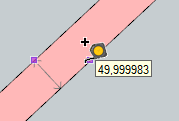
Very close - but surely it should be possible for full accuracy..?
-
I also noticed that if I crank up the decimals, I get an inaccurate measurement for that thickness (although a different one)

Now the very interesting thing is that I did not do any shearing but only worked with the rotate tool. So there could be inaccuracy but then it's Sketchup's tolerance when it merged two endpoints so close that I could see the electrons spinning. But then yes, I was indeed relying on this "tolerance" (just did not know how it will work).
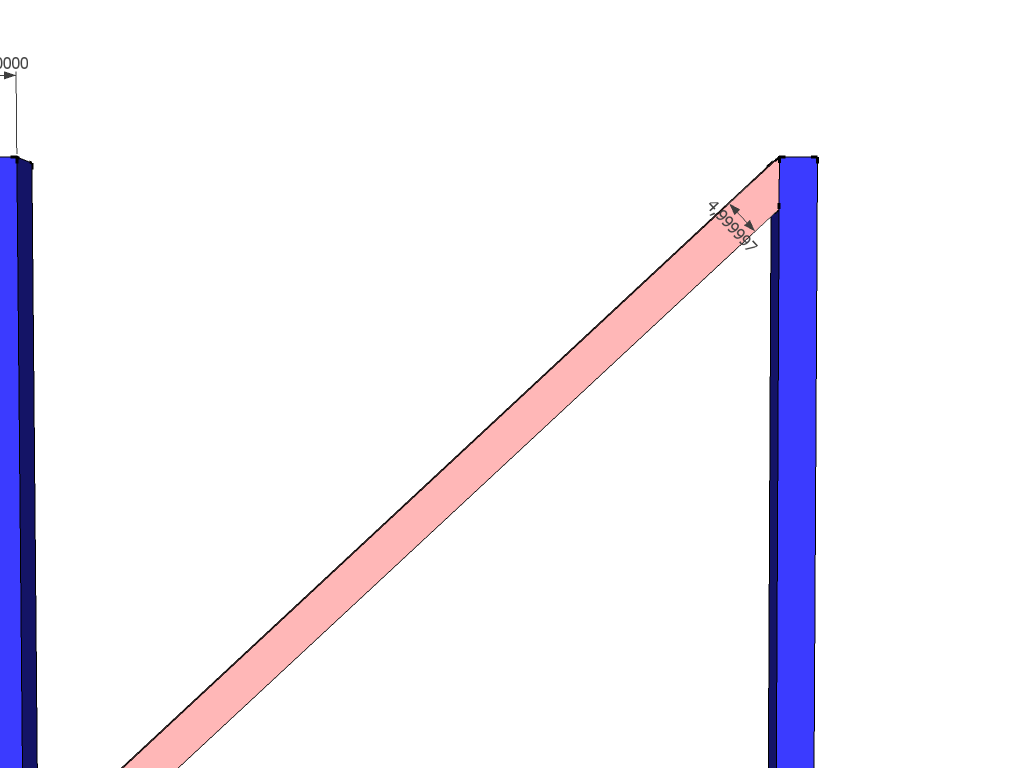
-
@thomthom said:
So how do you calculate it?
the way i calculate it in the DC :
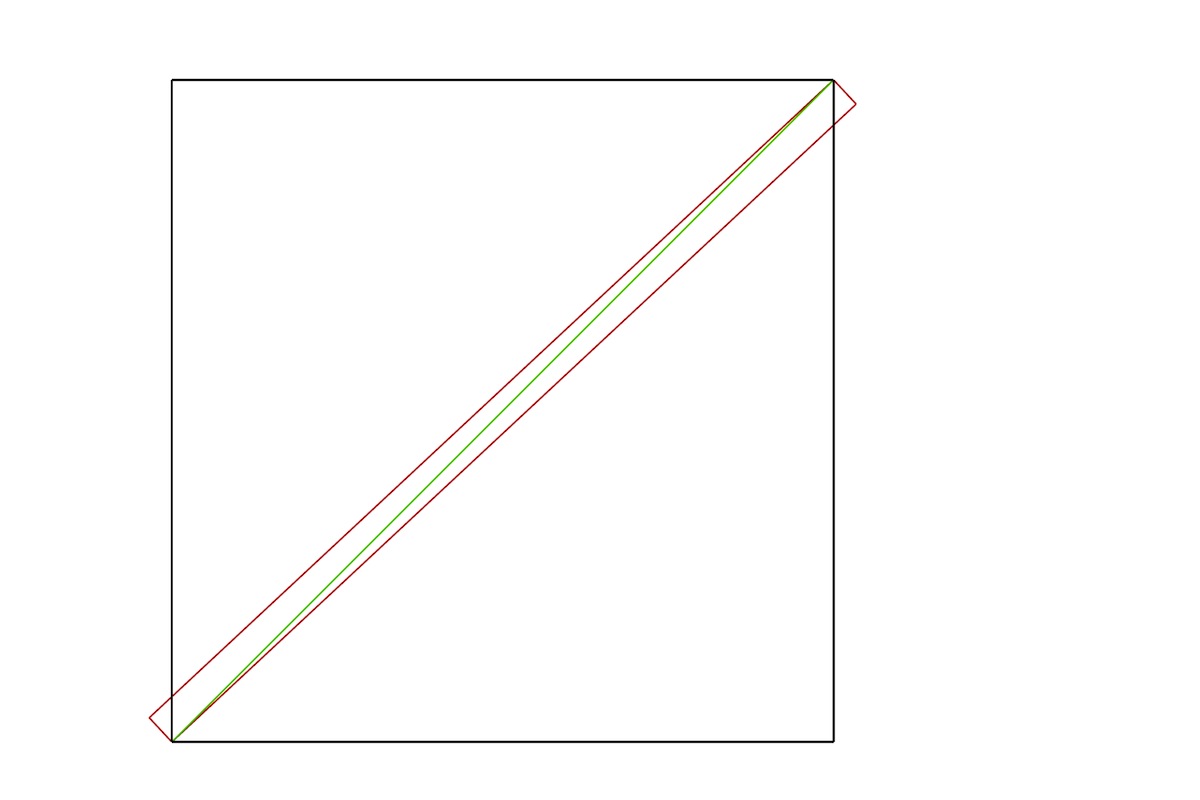
you can find all the info of the hypotenuse (green) in a variety of ways .. (for instance, a^2 + b^2 = c^2 to get its length.. you'll know a & b in this case… then trig for the angles)
that hypotenuse is also the the hypotenuse of the un-trimmed board (red).. so you know the board width and the length of its hypotenuse which means you can get all other angles and lengths..
the rotation of the original hypotenuse minus the long angle of the board's hypotenuse give the correct rotation angle..
here's the DC i use (after i use 'component options' to enter the dimension of height, board width, and the space in between the two poles, i'll then trace the results and copy/paste it into my actual drawing.. not entirely ideal but it works..)
for whatever reason, i still think there might be a way to do it in sketchup itself.. maybe jean L can come up with something

so far, it's looking like true-tangents may be the key.. i haven't tried it yet in this circumstance but i imagine it will work. -
Excellent, Jeff.
-
@unknownuser said:
@ecuadorian said:
@andybot said:
... thus - for best accuracy, draw it in ACAD and import into sketchup

Amen. Trimble, if you're reading this, we need actual arcs and curves in SketchUp.
i'm not quite sure they could give us true arcs in sketchup without entirely changing the way sketchup works.. (how would a cylinder be drawn if there were no segments in the arcs? a nurbs surface? )
what they can give us, i feel, is 'guide arcs' …which would also allow us to rotate this thing and snap it into place very easily.
.
Someone at Trimble is saying "What? There aren't real circles? Oh crap! What have we done?"
-
OK, what's wrong with Mac 1's version. Can the reference point from the tip to tip dimension be accurately placed on the horizontal guideline to give a marker for snap rotation of the board? I think it is the same problem, requiring math calculating length parallel to board tip to tip.
-
@ecuadorian said:
@andybot said:
... thus - for best accuracy, draw it in ACAD and import into sketchup

Amen. Trimble, if you're reading this, we need actual arcs and curves in SketchUp.
i'm not quite sure they could give us true arcs in sketchup without entirely changing the way sketchup works.. (how would a cylinder be drawn if there were no segments in the arcs? a nurbs surface? )
what they can give us, i feel, is 'guide arcs' …which would also allow us to rotate this thing and snap it into place very easily.. basically, a smarter rotate tool.
.
-
@pbacot said:
OK, what's wrong with Mac 1's version. Can the reference point from the tip to tip dimension be accurately placed on the horizontal guideline to give a marker for snap rotation of the board? I think it is the same problem, requiring math calculating length parallel to board tip to tip.
i'm still working through the thread.. checking mac's version next.. i'll report back

-
The DC is not working for me for some reason -- I see it and formulas, but no interactivity.
This is a variation on few similar solutions here -- but they all have a minor (or not so minor) variance -- it just does not make sense to me why

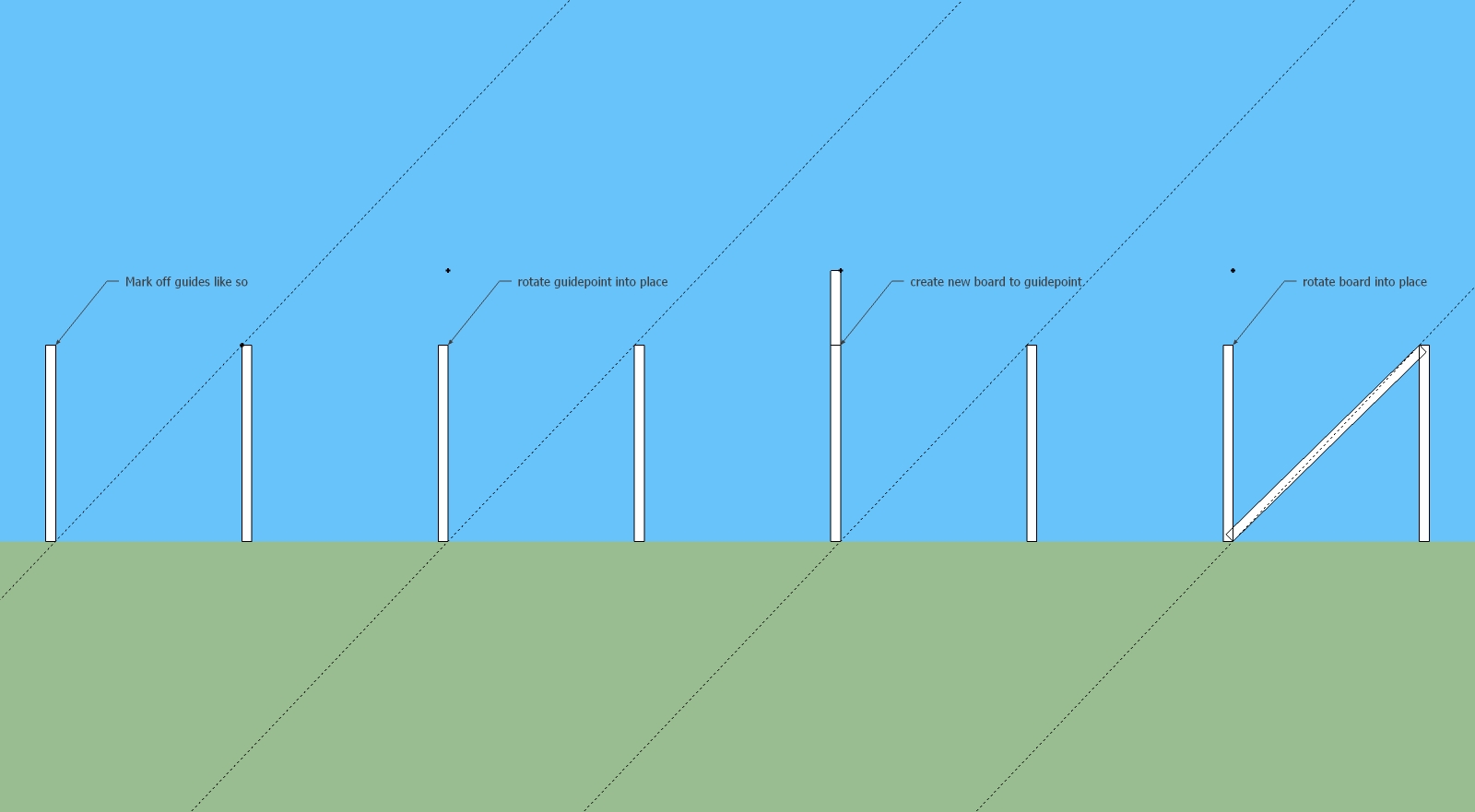
I mean the rotate tool should be accurate since it is not tied to polygons (like arc or circle), right?
Best,
Jason. -
maths, gotta love it. nice problem to post jeff!
tricky little problem, hitting opposite corners on that board. especially when graphically, you can't quite get there with sketch up.i've been working on a DC to sort of automate hip and valley creation in timber.
in order to get this far i've built a dc (both hip and valley) with sub components that are planes that rotate about with in the 'container' component. there are guidelines at the peak where this would potentially miter. the foot condition changes too much - so i usually do some solids work or intersecting with the model down there.here's a snap of the attributes (runs off the bottom of the window):
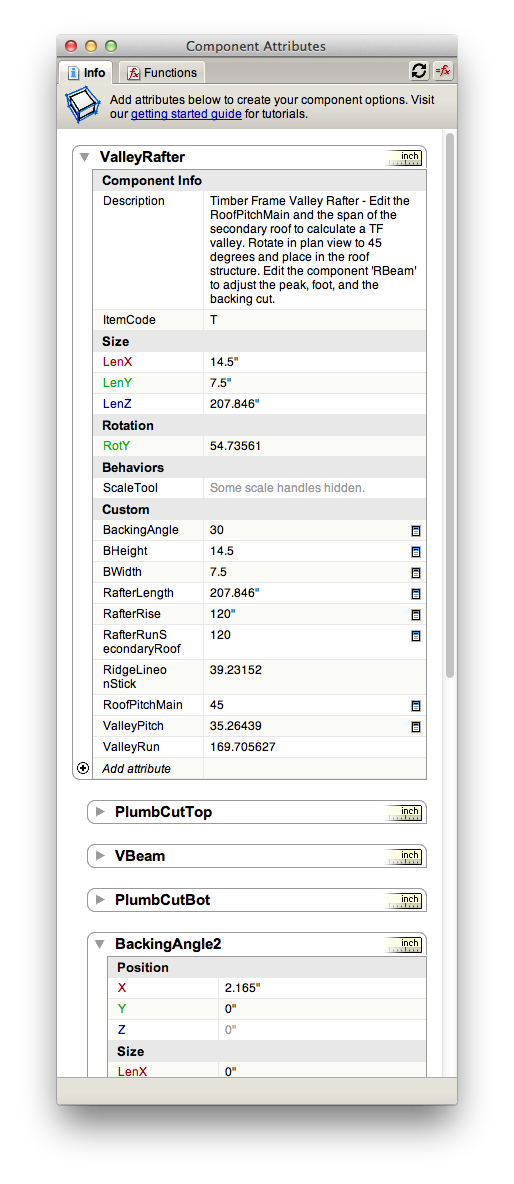
and the component:
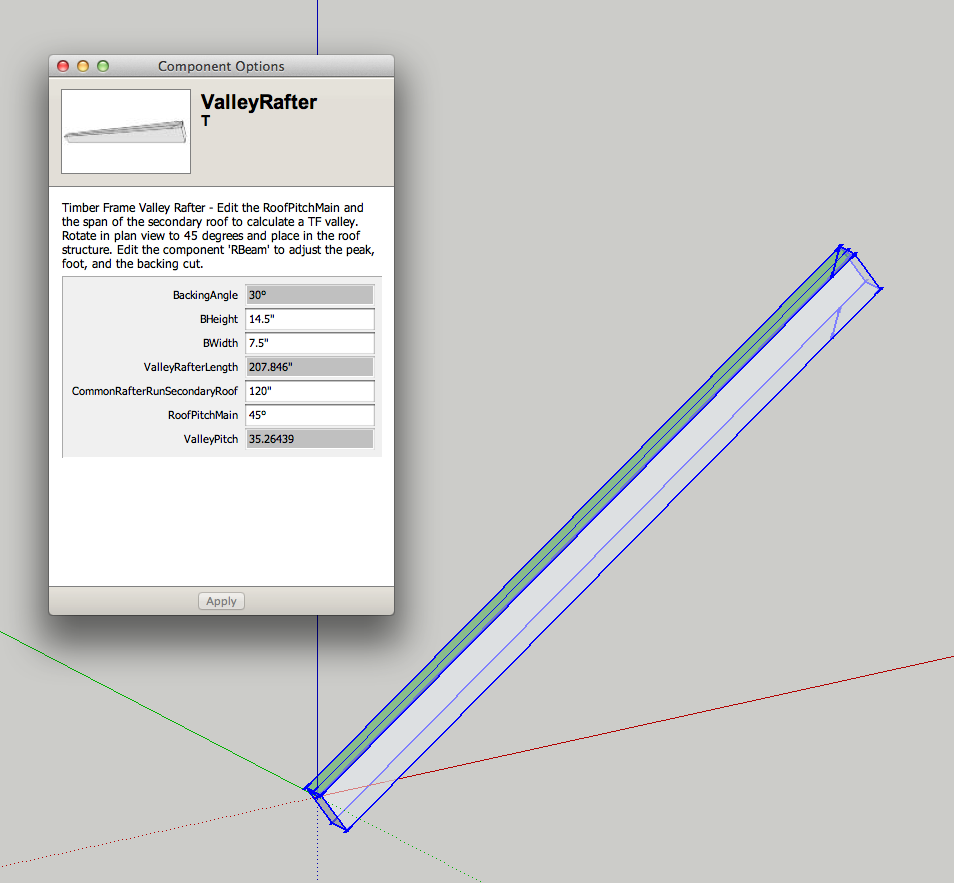
-
@unknownuser said:
@pbacot said:
OK, what's wrong with Mac 1's version. Can the reference point from the tip to tip dimension be accurately placed on the horizontal guideline to give a marker for snap rotation of the board? I think it is the same problem, requiring math calculating length parallel to board tip to tip.
i'm still working through the thread.. checking mac's version next.. i'll report back

yeah, that version doesn't work either.. when rotating the guide point downwards, there's no actual snap to the top of the board..
many of these methods would work if we could just rotate and snap to a random point along a line.. but we can only snap to a line's endpoints etc.. (in other words, a lot of people see what needs to be done.. it's just that we can't do it
 )
) -
@jason_maranto said:
The DC is not working for me for some reason -- I see it and formulas, but no interactivity.
use 'component options'.. not 'component attributes'..
-
@unknownuser said:
you can find all the info of the hypotenuse (green) in a variety of ways .. (for instance, a^2 + b^2 = c^2 to get its length.. you'll know a & b in this case… then trig for the angles)
that hypotenuse is also the the hypotenuse of the un-trimmed board (red).. so you know the board width and the length of its hypotenuse which means you can get all other angles and lengths..
I was suspecting something like that - but my trigonometry knowledge was all too poor that I dared place bets on it.
@unknownuser said:
for whatever reason, i still think there might be a way to do it in sketchup itself.. maybe jean L can come up with something
I also wonder this - but I also fear it might - due to lack of true arcs.
Where is Simon Le Bon btw..? -
@thomthom said:
@unknownuser said:
you can find all the info of the hypotenuse (green) in a variety of ways .. (for instance, a^2 + b^2 = c^2 to get its length.. you'll know a & b in this case… then trig for the angles)
that hypotenuse is also the the hypotenuse of the un-trimmed board (red).. so you know the board width and the length of its hypotenuse which means you can get all other angles and lengths..
I was suspecting something like that - but my trigonometry knowledge was all too poor that I dared place bets on it.
SOH CAH TOA

that's one of the things that seemed to stick with me after leaving school..
Sine = Opposite/Hypotenuse
Cosine = Adjacent/Hypotenuse
Tangent = Opposite/Adjacent -
That stuck with me, too. I can't remember who I took to prom, though.
-
@unknownuser said:
Sine = Opposite/Hypotenuse
Cosine = Adjacent/Hypotenuse
Tangent = Opposite/AdjacentTrouble is that I don't even remember what to use of this. I'm really annoying - I always have to look up this stuff, reading for a while, whenever I need to do such work with my plugins. ...which, when you place plugins for 3D software... ...I really should be knowing this...

-
@jason_maranto said:
Well, I figured out some of the accuracy issue on my last approach -- a bit of user error on my part since I was rotating the guidepoint to the wrong place and also the accuracy setting of the rotate tool was not set high enough... actually this still isn't exactly accurate (rotated to 45.6085) but it's pretty close now.
Try with the posts further apart - then you'll catch accuracy issue much easier. When it's close to 45 degrees it's harder to spot.
-
Well, I figured out some of the accuracy issue on my last approach -- a bit of user error on my part since I was rotating the guidepoint to the wrong place and also the accuracy setting of the rotate tool was not set high enough... actually this still isn't exactly accurate (rotated to 45.6085) but it's pretty close now.
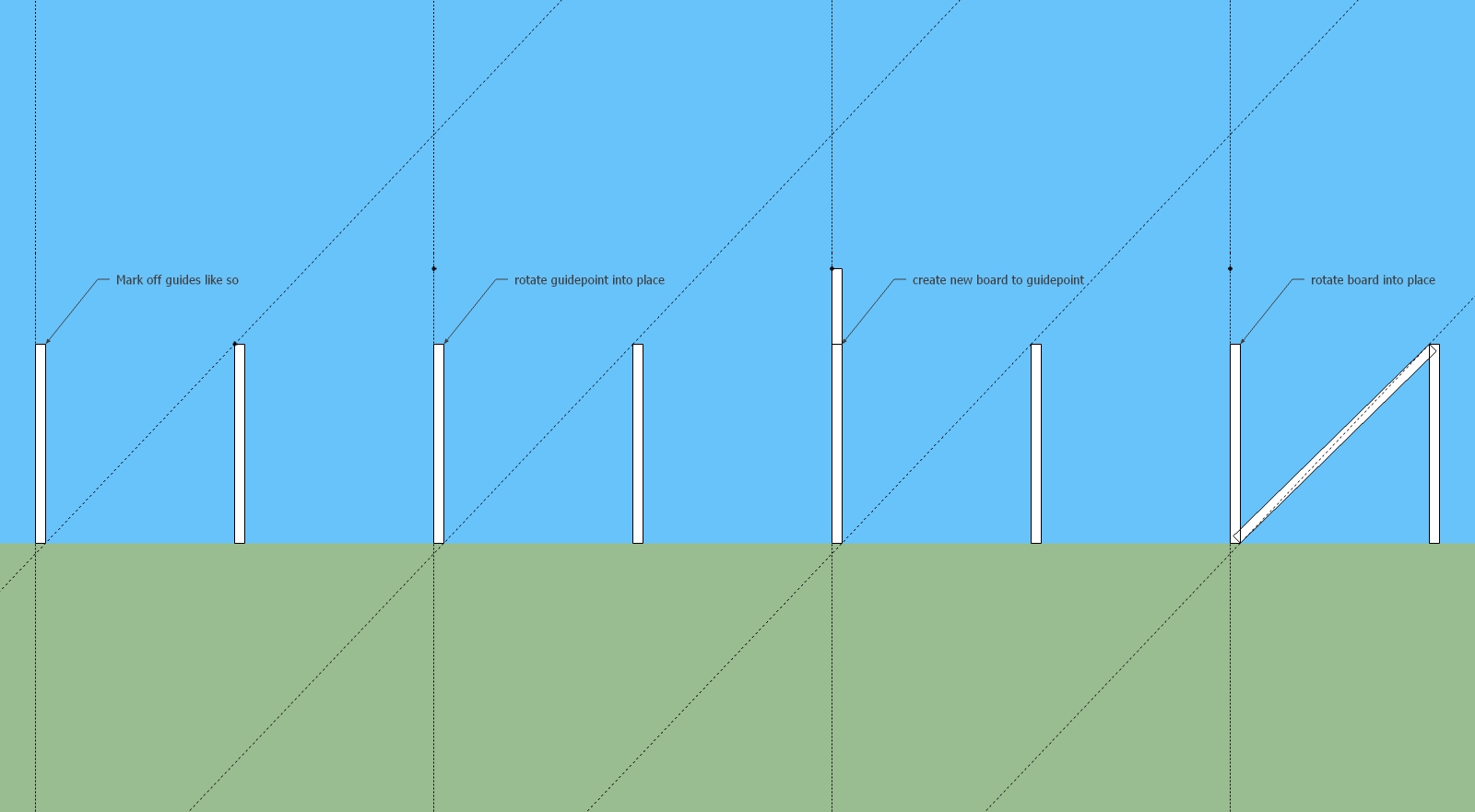
@Jeff - I checked every aspect of interacting with a DC, it shows nothing for me.
Edit -- Gotcha, you have to actually open the model instead of bringing it in as a component.
Best,
Jason. -
@jason_maranto said:
@Jeff - I checked every aspect of interacting with a DC, it shows nothing for me.
oh man.. that reminds me of some problem with sharing dynamic components.. are you directly opening the file i posted or are you bringing it in to an existing model?
you have to just open the file i posted then the options should be available..
(or something like that.. i remember having problems with bringing in DCs from the warehouse into existing models and none of the options were available.)
i remember having problems with bringing in DCs from the warehouse into existing models and none of the options were available.) -
@thomthom said:
@unknownuser said:
Sine = Opposite/Hypotenuse
Cosine = Adjacent/Hypotenuse
Tangent = Opposite/AdjacentTrouble is that I don't even remember what to use of this. I'm really annoying - I always have to look up this stuff, reading for a while, whenever I need to do such work with my plugins. ...which, when you place plugins for 3D software... ...I really should be knowing this...

ha.. i always figured you ruby gurus were math wizards..

nice to know you're sitting around looking things up on a per case basis like the rest of us
Advertisement







